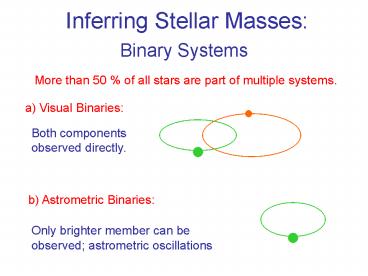Inferring Stellar Masses: - PowerPoint PPT Presentation
1 / 9
Title:
Inferring Stellar Masses:
Description:
Approaching star: blue shifted lines; Receding star: red shifted lines ... Two superimposed, discernible spectra from the 2 stars; periodic, opposite shifts: ... – PowerPoint PPT presentation
Number of Views:22
Avg rating:3.0/5.0
Title: Inferring Stellar Masses:
1
Inferring Stellar Masses
0
- Binary Systems
More than 50 of all stars are part of multiple
systems.
a) Visual Binaries
Both components observed directly.
b) Astrometric Binaries
Only brighter member can be observed astrometric
oscillations
2
c) Eclipsing Binaries
0
Inclination 90o
In addition to stellar masses, infer relative
temperatures and radii
3
d) Spectrum Binaries
0
Two superimposed, discernible spectra from the 2
stars periodic, opposite shifts
Approaching star blue shifted lines Receding
star red shifted lines
Doppler shift ? Measurement of radial velocities
? Estimate of separation a
? Estimate of masses
4
0
Time
5
e) Spectroscopic Binaries
0
Only one star and one absorption line system seen
Periodic Doppler shifts.
2 Dl
? Place limits on the mass of the unseen component
6
Visual Binaries
0
- The Ideal Case
Basically all parameters can be determined
observer
i
M1
a2
a1
M2
7
Eclipsing Binaries
0
i 90o sin i 1
f(M) M23/(M1 M2)2
8
Estimating Radii and Temperatures in Eclipsing
Binaries
0
B0
Brightness B
Bs
Bp
tc
Time t
ta
tb
td
9
Masses of Stars in the Hertzsprung-Russell Diagram
0
Masses in units of solar masses
40
18
The higher a stars mass, the more luminous
(brighter) it is
High masses
6
3
L M3.5
1.7
1.0
High-mass stars have much shorter lives than
low-mass stars
Mass
0.8
0.5
tlife M-2.5
Sun 10 billion yr.
Low masses
10 Msun 30 million yr.
0.1 Msun 3 trillion yr.

